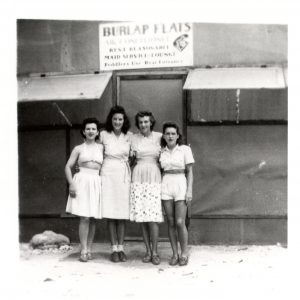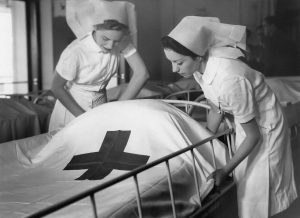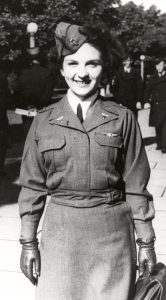Meet the former US Army flight nurses whom I interviewed for
Beyond the Call of Duty: Army Flight Nursing in World War II.
In 1986 as part of my research about flight nurse history and coping with war, I was privileged to interview 25 former US Army nurses about events of their flight nurse duty in World War II. Most of them are now deceased, but their stories live on in Beyond the Call of Duty: Army Flight Nursing in World War II.
The journal I kept of my time with each of them in 1986 when writing my dissertation offers a brief personal glimpse of these remarkable women. I am sharing edited versions of these journals, in the order in which the interviews took place. The actual interviews are in separate documents.
22nd Interview
Randy Rast Weinrich
803 MAES China-Burma-India
19 June 1986
I met with Randy Weinrich in her home in Hemet, California. I had flown from San Antonio to Palm Springs, and I had driven a rental car the 28 or so miles to Hemet, which is a small town that grew out of a farm community.
Randy is a very attractive woman, carefully groomed. She was casually dressed. She took me to her favorite spot in the house for our interview—a corner of the living room with adjoining windows that offer a magnificent view of the area from the Weinrich’s hilltop home. She offered me a glass of water, and we casually discussed a number of topics. Then lest the casual conversation fill the afternoon, I eventually introduced the “ground rules” of the interview itself—how long it might last and a general outline of the questions.
I’m afraid my expectations for this interview may have been a bit too high. I was so excited that I’d found a flight nurse who was assigned to the China-Burma-India Theater (CBI)—Randy was assigned in China most of her overseas tour—that I assumed she would have many interesting experiences to relate. I was a bit disappointed that she actually had relatively little information to share. Some of those experiences were very relevant to my study, however.
Three of the four flights in the squadron were based in Upper Assam, India, but Randy’s flight was assigned to China. The six nurses in Randy’s flight were scattered all over China; Randy was stationed at Kunming. In theory, the other nurses in China would bring patients to Kunming, from where Randy would then fly with the patients over the Hump. In reality, she says, there was not much flying.
During the interview Randy served coffee and sweets, and we chatted easily. But my overall impression was that perhaps neither of us knew quite what to expect from the other. It was, however, an afternoon well spent.
Some of Randy’s stories: Randy had a lot of funny things happen during her years as a flight nurse overseas. One time when she went to India, the flight nurses there were weaving a walkway from the tents to where the toilet facilities were. They named their walkway the “P-38 Runway.” When Randy got back to China, she wrote the nurses and asked them in her letter how the “P-38 Runway” was coming. That part was censored and cut out of her letter before the nurses received it. Randy talked about the closeness of the flight nurses in her squadron, who “seemed more like sisters to me than my own sisters, because wartime is different.” Everyone was a friend, not a stranger during war. She used as an example care packages sent from home, which “you wouldn’t think of consuming it by yourself—you passed it around.”
Randy died in 2005.



